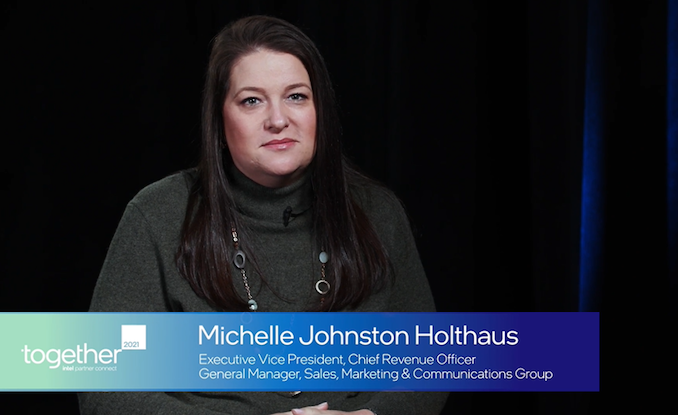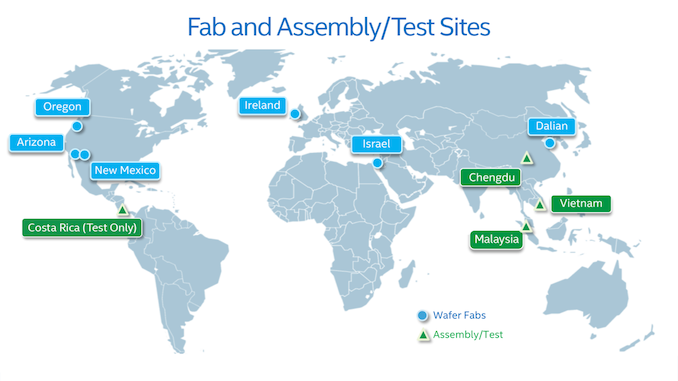Intel’s Chief Revenue Officer: We have Silicon, but Shortages in Wi-Fi, Substrates, Panels
by Dr. Ian Cutress on May 4, 2021 7:00 AM EST
One of the key commentaries about the current semiconductor shortages is around where exactly the bottlenecks are. The traditional interpretation of a semiconductor shortage implies that not enough silicon can be made, but over the last few months a number of companies have pointed to post-silicon production, such as testing and packaging, causing some of the issues. To the best of our knowledge, none of the companies affected by the shortages are specifically pointing at partner companies or specific supply chain areas where there is a bottleneck, however there have been a number of comments focused in the direction of packaging, substrates, and the specialist films involved for high performance compute.
AnandTech has learned that at its Partner Connect 2021 event recently, Intel Chief Revenue Officer Michelle Johnston Holthaus expanded the dimensions to which the supply chain is causing the semiconductor shortage for Intel's partners. During the event Keynote, as part of a planned Q&A session with the host John Kalvin (Intel GM of Scale and Partner Organization), Holthaus expanded on the commentary surrounding Intel’s silicon flow and where the supply chain bottlenecks are for Intel and associated partners.
Holthaus states that due to Intel’s investment over the last three years to increase silicon output on its leading edge process technologies, it has doubled its silicon production, and continuing to invest in that area of the business. However the industry has increased in PC units by 33%-50% over the past two years, and other ancillary ecosystem components are now in short supply, including substrates as previously mentioned, but Holthaus also notes that Wi-Fi modules and display panels are also part of that ecosystem limitation. The company has plenty of silicon waiting to be packaged apparently, but partners looking for a complete set of components for complex machine integration are having additional difficulty,
As part of the discussion, Holthaus highlights Intel’s multi-decade approach to working with its component ecosystem partners to drive volume, however despite Intel increasing its silicon volumes by such a large amount, it would appear that the ecosystem partner investment was not of the same order of magnitude.
Despite Intel being an integrated device manufacturer (IDM, as CEO Pat Gelsinger is promoting) and aiming for complete vertical integration, much like TSMC and Samsung, Intel is still at the whim of parts of the supply chain it doesn’t control. While Intel may have investments in those areas of the supply chain, they need to be stepped up in line with the rest of Intel’s business. TSMC’s Chairman Mark Liu said in a recent 60 Minutes segment regarding the current semiconductor shortage that the timescales for these investments are longer than people realise – currently TSMC can meet the minimum requirement for its customers, but shortages will last for a good 6-9 months for automotive, for example.
Intel this week announced a $3.5 Billion USD investment in its 3D packaging technologies in Rio Rancho, New Mexico. However this production line is for future technologies and is not expected to be operational until late 2022.
The full comments by Intel CRO Michelle Johnston Holthaus have been transcribed below.
Supply has been a topic since 2019, really since the end of 2018. Intel continues to increase our capacity by two fold over those years. We’re continuing to build more and more, amd we’re continuing to increase our investments in CapEx as you heard Pat talk about. The real thing here is that demand continues to be strong and with COVID and the pandemic it has gotten even stronger.
We’ve seen that the PC has become essential to the way people work and interact on a daily basis. We don’t see that changing. We’re up to over a million PCs being shipped a day. That is massive TAM growth when you think about where we were in 2018 to where we are now, we’re now up 75-100m units in TAM in a very short amount of time. The good news is that with our investments at Intel and our increases in capacity, we can build the die to be able to supply well over market demand.
But what we’re now seeing is that there are new industry and ecosystem challenges where the rest of the component ecosystem can’t keep up. Whether it’s Wi-Fi components, substrates, panels, those are now kind of the bottleneck to the next level of explosive growth. So you might be able to find a CPU, but you may not be able to find a panel, or a battery, or some other component to actually be able to finish that kit.
We have plenty have silicon dies and I want everyone to know that those investments are absolutely paying off, and now we have got to go work on all the ecosystem pieces. We understand those shortages cause a lot of stress and a lot of frustration and we’re doing everything we can to maximize our mix, our output, so that our customers and partners can deliver what they have committed to their shareholders and partners. Pat is 100% committed to continuing to invest.
Related Reading
- Intel to Invest $3.5 Billion USD into Foveros and EMIB Production in Rio Rancho
- Intel Confirms Tiger Lake-U Refresh Later in 2021
- TSMC Update: 2nm in Development, 3nm and 4nm on Track for 2022
- Sales of Fab Tools Surge to Over $71 Billion in 2020
- TSMC Q1 2021 Process Node Revenue: More 7nm, No More 20nm
- SK Hynix to Build $106 Billion Fab Cluster: 800,000 Wafer Starts a Month
- TSMC to Spend $100B on Fabs and R&D Over Next Three Years: 2nm, Arizona Fab & More
- Intel to Revive ‘Tick-Tock’ Model, Unquestioned CPU Leadership Performance in 2024/2025
- Intel’s New IDM 2.0 Strategy: $20b for Two Fabs
- Intel’s x86 Designs No Longer Limited to Intel on Intel: IP Blocks for Foundry, Cores on TSMC











23 Comments
View All Comments
flgt - Tuesday, May 4, 2021 - link
CRO, that's a new one for me. You would think that with all the executives Intel has someone would be watching this stuff. It's interesting to contrast them with Tim Cook at Apple who has background in supply chain. His team seems to be able to accurately forecast demand for the most part (they have a few misses) and get the whole supply chain going. They lock in the TSMC wafers. If a critical supplier will be a bottleneck they advance them millions or billions of dollars to ensure they have infrastructure in place.Matthias B V - Tuesday, May 4, 2021 - link
Yes also first time heard if this. Maybe "revenue" would be better without all those officers.What's next: CBO - Chief Breakfast Officer? We often joked during studies that Breakfast Director would be the perfect job. Maybe Intel makes it work!
Spunjji - Friday, May 7, 2021 - link
I was going to joke about COO - "Chief Officer Officer", the officer in charge of deciding how many officers there should be - then realised COO is already a thing. 🤦♂️ I guess someone thought COO sounded better than "Deputy CEO".PaulHoule - Tuesday, May 4, 2021 - link
Note Intel is a vendor in this story; they're not the ones who have screwed up supply chains, it is their customers. Ultimately the stress goes all the way to the retailer, enterprise customer, and gets distributed by all the parties.Apple frequently announces that they will stop production of this mac or that phone but there is usually something new and better and most customers feel good about it.
Dell sells whole laptop fleets to firms with 10,000+ employee(s) and in a case like that the customer wants predictability and they get it -- a Dell Latitude laptop is a quality product in the sense that the Toyota Corolla is. (Go for the gaming or 'desktop replacement' Dell brands and you might need to bribe a grad student to reflow the motherboard.)
Apple on the other hand has pricing power, if they are running short they can raise the price and people will still pay. If they are stacking up they can lower the price and still make a profit.
mode_13h - Sunday, May 9, 2021 - link
> Dell sells whole laptop fleets to firms with 10,000+ employee(s) and> in a case like that the customer wants predictability and they get it
My employer bought some entry-level fiexed workstations, a few years ago and the failure rate was the worst I'd ever personally witnessed! And it wasn't just one component, either. We had failed SSDs, hard drives, and motherboards! And this was across multiple batches ordered in consecutive months and multiple different office locations!
These machines weren't cheap, either. They cost north of $2200 each, after our corporate discount. And that's for a configuration that still used integrated graphics!
Prior to that, my experiences with their flagship 2U servers were positive, as well as their mid-range workstations. We even have several 10-year old Dell servers that have been operating continuously!
mode_13h - Sunday, May 9, 2021 - link
> fiexed workstationsfixed workstations, I mean. They were "Precision Tower 3620", specifically.
Hulk - Tuesday, May 4, 2021 - link
Okay I get it, they have sand. Thanks for letting us know.PaulHoule - Tuesday, May 4, 2021 - link
If Intel is up for some bold thinking, here it is.If WiFi parts are short, build units without WiFi. It's time to show people what speed they can experience with 10G Ethernet, and how much speed other WiFi users can enjoy because you aren't stomping over their bandwidth. What is that? 5x performance improvement in one generation!
Display Panels are short? Make desktops. People are stuck at home now and won't need to lug laptops through the airport, shopping mall, monster truck stadium, wherever they go. DIY is the thing these days so go for liquid cooling installations that are connected to the water mains and have stylish bubblers like the liquid cooled crays of old.
It drives me nuts what a rip-off computer displays seem to be compared to TV sets. People should vote with their feet.
RSAUser - Thursday, May 6, 2021 - link
This is not Intel, this is its partners that deliver the finished products like laptops and pre-builts.YB1064 - Tuesday, May 4, 2021 - link
The "CRO"'s comments...what a bunch of bullshit. Still stuck on 14nm+++^n.